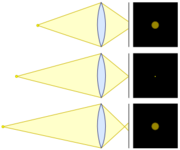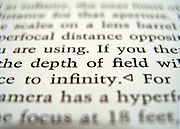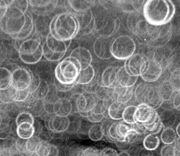
Bokeh
Encyclopedia

Photography
Photography is the art, science and practice of creating durable images by recording light or other electromagnetic radiation, either electronically by means of an image sensor or chemically by means of a light-sensitive material such as photographic film...
, bokeh (Originally icon, icon , and also sometimes heard as icon ,
boke) is the blur, or the aesthetic quality of the blur, in out-of-focus areas of an image, or "the way the lens renders out-of-focus points of light."
Differences in lens aberrations and aperture
Aperture
In optics, an aperture is a hole or an opening through which light travels. More specifically, the aperture of an optical system is the opening that determines the cone angle of a bundle of rays that come to a focus in the image plane. The aperture determines how collimated the admitted rays are,...
shape cause some lens
Photographic lens
A camera lens is an optical lens or assembly of lenses used in conjunction with a camera body and mechanism to make images of objects either on photographic film or on other media capable of storing an image chemically or electronically.While in principle a simple convex lens will suffice, in...
designs to blur the image in a way that is pleasing to the eye, while others produce blurring that is unpleasant or distracting—"good" and "bad" bokeh, respectively.
Bokeh occurs for parts of the scene that lie outside the depth of field
Depth of field
In optics, particularly as it relates to film and photography, depth of field is the distance between the nearest and farthest objects in a scene that appear acceptably sharp in an image...
. Photographers sometimes deliberately use a shallow focus
Shallow focus
Shallow focus is a photographic and cinematographic technique incorporating a small depth of field. In shallow focus one plane of the image is in focus while the rest is out of focus. Shallow focus is typically used to emphasize one part of the image over another...
technique to create images with prominent out-of-focus regions.
Bokeh is often most visible around small background highlights, such as specular reflections and light sources, which is why it is often associated with such areas. However, bokeh is not limited to highlights; blur occurs in all out-of-focus regions of the image.
Origin
The term comes from the JapaneseJapanese language
is a language spoken by over 130 million people in Japan and in Japanese emigrant communities. It is a member of the Japonic language family, which has a number of proposed relationships with other languages, none of which has gained wide acceptance among historical linguists .Japanese is an...
word boke ( or ), which means "blur" or "haze", or boke-aji , the "blur quality". The Japanese term boke is also used in the sense of a mental haze or senility. The term bokashi is related, meaning intentional blurring or gradation.
The English spelling bokeh was popularized in 1997 in Photo Techniques magazine, when Mike Johnston, the editor at the time, commissioned three papers on the topic for the March/April 1997 issue; he altered the spelling to suggest the correct pronunciation to English speakers, saying "it is properly pronounced with bo as in bone and ke as in Kenneth, with equal stress on either syllable".
The spellings bokeh and boke have both been in use at least since 1996, when Merklinger had suggested "or Bokeh if you prefer."
The term bokeh has appeared in photography books at least since 1998.
It is sometimes pronounced ˈ (boke-uh).
Description
Although difficult to quantify, some lenses enhance overall image quality by producing more subjectively pleasing out-of-focus areas. Good bokeh is especially important for large-apertureAperture
In optics, an aperture is a hole or an opening through which light travels. More specifically, the aperture of an optical system is the opening that determines the cone angle of a bundle of rays that come to a focus in the image plane. The aperture determines how collimated the admitted rays are,...
lenses, macro lenses, and long telephoto lens
Telephoto lens
In photography and cinematography, a telephoto lens is a specific type of a long-focus lens in which the physical length of the lens is shorter than the focal length. This is achieved by incorporating a special lens group known as a telephoto group that extends the light path to create a long-focus...
es because they are typically used with a shallow depth of field
Depth of field
In optics, particularly as it relates to film and photography, depth of field is the distance between the nearest and farthest objects in a scene that appear acceptably sharp in an image...
. Bokeh is also important for medium telephoto "portrait lenses" (typically 85–150 mm on 35 mm format) because in portraiture photography, the photographer typically seeks to obtain a shallow depth of field to achieve an out-of-focus background and make the subject stand out.
Bokeh characteristics may be quantified by examining the image's circle of confusion
Circle of confusion
In optics, a circle of confusion is an optical spot caused by a cone of light rays from a lens not coming to a perfect focus when imaging a point source...
. In out-of-focus areas, each point of light becomes an image of the aperture, generally a more or less round disc. Depending how a lens is corrected for spherical aberration
Spherical aberration
thumb|right|Spherical aberration. A perfect lens focuses all incoming rays to a point on the [[Optical axis|optic axis]]. A real lens with spherical surfaces suffers from spherical aberration: it focuses rays more tightly if they enter it far from the optic axis than if they enter closer to the...
, the disc may be uniformly illuminated, brighter near the edge, or brighter near the center. Lenses that are poorly corrected for spherical aberration will show one kind of disc for out-of-focus points in front of the plane of focus, and a different kind for points behind. This may actually be desirable, as blur circles that are dimmer near the edges produce less-defined shapes which blend smoothly with the surrounding image.
Lens manufacturers including Nikon
Nikon
, also known as just Nikon, is a multinational corporation headquartered in Tokyo, Japan, specializing in optics and imaging. Its products include cameras, binoculars, microscopes, measurement instruments, and the steppers used in the photolithography steps of semiconductor fabrication, of which...
, Minolta
Minolta AF
The Minolta Alpha camera system was a collection of photographic equipment from Minolta. The system used a lens mount called A-mount, with a flange focal distance 44.50 mm. The new mount was larger than the older SR-mount making old manual lenses incompatible with the new system...
, and Sony make lenses designed with specific controls to change the rendering of the out-of-focus areas.
 |
 |
|
 |
 |
 |
The shape of the aperture has an influence on the subjective quality of bokeh as well. For conventional lens designs (with bladed apertures), when a lens is stopped down smaller than its maximum aperture
Aperture
In optics, an aperture is a hole or an opening through which light travels. More specifically, the aperture of an optical system is the opening that determines the cone angle of a bundle of rays that come to a focus in the image plane. The aperture determines how collimated the admitted rays are,...
size (minimum f-number
F-number
In optics, the f-number of an optical system expresses the diameter of the entrance pupil in terms of the focal length of the lens; in simpler terms, the f-number is the focal length divided by the "effective" aperture diameter...
), out-of-focus points are blurred into the polygon
Polygon
In geometry a polygon is a flat shape consisting of straight lines that are joined to form a closed chain orcircuit.A polygon is traditionally a plane figure that is bounded by a closed path, composed of a finite sequence of straight line segments...
al shape formed by the aperture blades. This is most apparent when a lens produces hard-edged bokeh. For this reason, some lenses have many aperture blades and/or blades with curved edges to make the aperture more closely approximate a circle rather than a polygon. Minolta has been on the forefront of promoting and introducing lenses with near-ideal circular apertures since 1987, but, since bokeh has become a recognized property of lenses, most other manufacturers now offer lenses with shape-optimized diaphragms, at least for the domain of portraiture photography. In contrast, a catadioptric
Catadioptric
A catadioptric optical system is one where refraction and reflection are combined in an optical system, usually via lenses and curved mirrors . Catadioptric combinations are used in focusing systems such as search lights, headlamps, early lighthouse focusing systems, optical telescopes,...
telephoto lens
Telephoto lens
In photography and cinematography, a telephoto lens is a specific type of a long-focus lens in which the physical length of the lens is shorter than the focal length. This is achieved by incorporating a special lens group known as a telephoto group that extends the light path to create a long-focus...
renders bokehs resembling doughnuts, because its secondary mirror
Secondary mirror
A secondary mirror is the second deflecting or focusing mirror element in a reflecting telescope. Light gathered by the primary mirror is directed towards a focal point typically past the location of the secondary. Secondary mirrors in the form of an optically flat diagonal mirror are used to...
blocks the central part of the aperture opening. Recently, photographers have exploited the shape of the bokeh by creating a simple mask out of card with shapes such as hearts or stars, that the photographer wishes the bokeh to be, and placing it over the lens.
Leica lenses, especially vintage ones, are often claimed to excel in bokeh quality, although Leica photographers have tended to make more use of maximum aperture due to the lenses' ability to maintain good sharpness at wide openings and the suitability of the Leica camera system for available-light theatre work and reportage. This reputation is founded on the excellence of Leitz/Leica pre-war
World War II
World War II, or the Second World War , was a global conflict lasting from 1939 to 1945, involving most of the world's nations—including all of the great powers—eventually forming two opposing military alliances: the Allies and the Axis...
lenses, which were at the forefront of complex mathematical design and manufacturing know-how, at a time when all computations and glass making were done by hand.
The Minolta/Sony STF 135mm f/2.8 [T4.5] (with STF standing for smooth trans focus) is a lens which is specifically designed to produce pleasing bokeh. An apodization
Apodization
Apodization literally means "removing the foot". It is the technical term for changing the shape of a mathematical function, an electrical signal, an optical transmission or a mechanical structure.- Apodization in signal processing :...
filter is used to soften the aperture edges which results in a smooth defocused area with gradually fading circles. Those qualities make it the only lens of this kind currently on the market.
The Nikon 105mm DC and 135mm DC lenses (DC stands for "Defocus Control") have a control ring that permits the over-correction or under-correction of spherical aberration
Spherical aberration
thumb|right|Spherical aberration. A perfect lens focuses all incoming rays to a point on the [[Optical axis|optic axis]]. A real lens with spherical surfaces suffers from spherical aberration: it focuses rays more tightly if they enter it far from the optic axis than if they enter closer to the...
to change the bokeh in front of and behind the focal plane
Cardinal point (optics)
In Gaussian optics, the cardinal points consist of three pairs of points located on the optical axis of an ideal, rotationally symmetric, focal, optical system...
.
Emulation
Bokeh can be simulated by convolvingConvolution
In mathematics and, in particular, functional analysis, convolution is a mathematical operation on two functions f and g, producing a third function that is typically viewed as a modified version of one of the original functions. Convolution is similar to cross-correlation...
the image with a kernel that corresponds to the image of an out-of-focus point source taken with a real camera. Unlike conventional convolution, this convolution has a kernel that depends on the distance of each image point and – at least in principle – has to include image points that are occluded by objects in the foreground. Also, bokeh is not just any blur. To a first approximation, defocus blur is convolution by a uniform disk
Disk (mathematics)
In geometry, a disk is the region in a plane bounded by a circle.A disk is said to be closed or open according to whether or not it contains the circle that constitutes its boundary...
, a more computationally intensive operation than the "standard" Gaussian blur
Gaussian blur
A Gaussian blur is the result of blurring an image by a Gaussian function. It is a widely used effect in graphics software, typically to reduce image noise and reduce detail...
; the former produces sharp circles around highlights whereas the latter is a much softer effect. Diffraction
Diffraction
Diffraction refers to various phenomena which occur when a wave encounters an obstacle. Italian scientist Francesco Maria Grimaldi coined the word "diffraction" and was the first to record accurate observations of the phenomenon in 1665...
may alter the effective shape of the blur. Some graphics editors have a filter to do this, usually called "Lens Blur."
An alternative mechanical mechanism has been proposed for generating bokeh in small aperture cameras such as compacts or cellphone cameras, called image destabilisation, in which both the lens and sensor are moved in order to maintain focus at one focal plane, while defocusing nearby ones. This effect currently generates blur in only one axis.
Other applications
Recently, a research group at MIT Media LabMIT Media Lab
The MIT Media Lab is a laboratory of MIT School of Architecture and Planning. Devoted to research projects at the convergence of design, multimedia and technology, the Media Lab has been widely popularized since the 1990s by business and technology publications such as Wired and Red Herring for a...
showed that the bokeh effect can be used to make imperceptibly small barcodes, or bokode
Bokode
A bokode is a type of data tag which holds thousands of times more information than a barcode. They were developed by a team at the MIT Media Lab. The bokode pattern is a tiled series of Data Matrix codes. The name is a portmanteau of the words bokeh and barcode – rewritable bokodes are called...
s. By using markers as small as 3mm with a small lens over them, if the marker is viewed out of focus through an ordinary camera focused at infinity, the resulting image is large enough to scan the information in the barcode.
See also
- Aberration in optical systemsAberration in optical systemsAberrations are departures of the performance of an optical system from the predictions of paraxial optics. Aberration leads to blurring of the image produced by an image-forming optical system. It occurs when light from one point of an object after transmission through the system does not converge...
- Airy disk
- Circle of confusionCircle of confusionIn optics, a circle of confusion is an optical spot caused by a cone of light rays from a lens not coming to a perfect focus when imaging a point source...
- Soft focusSoft focusIn photography, soft focus is a lens flaw, in which the lens forms images that are blurred due to spherical aberration. A soft focus lens deliberately introduces spherical aberration in order to give the appearance of blurring the image while retaining sharp edges; it is not the same as an...
- Special effectSpecial effectThe illusions used in the film, television, theatre, or entertainment industries to simulate the imagined events in a story are traditionally called special effects ....
External links
- Aperture Simulator Java iris and effect simulator
- How to evaluate bokeh
- Understanding Bokeh

